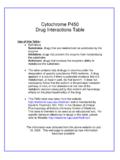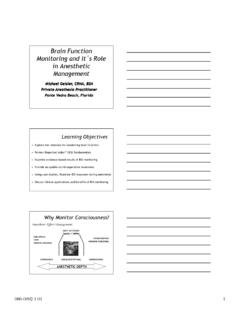Transcription of Anaesthesia and analgesia for surgery in rabbits …
1 Thesis for doctoral degree ( )2008 Anaesthesia and analgesia for surgery inrabbits and rats: A comparison of the effectsof different compoundsPatricia HedenqvistThesis for doctoral degree ( ) 2008 Patricia HedenqvistAnaesthesia and analgesia for surgery in rabbits and rats: A comparison of the effects of different compounds From the Department of Physiology and Pharmacology, Karolinska Institutet, Stockholm, Sweden Anaesthesia and analgesia for surgery in rabbits and rats: A comparison of the effects of different compounds Patricia Hedenqvist Stockholm 2008 2008G rdsv gen 4, 169 70 SolnaPrinted byAll previously published papers were reproduced with permission from the publisher. Published by Karolinska Institutet. Front cover copyright 2005 Jin Wicked. Used with permission. Patricia Hedenqvist, 2008 ISBN 978-91-7357-578-2 ABSTRACT Studies of Anaesthesia and analgesia in rats and rabbit were undertaken with the aim to improve anesthesia techniques, for better animal welfare and research quality.
2 Induction of Anaesthesia with the volatile halogenated agents isoflurane, sevoflurane and desflurane was compared in the New Zealand White rabbit. All agents caused struggling, breath holding and reflex bradycardia, desflurane having the least detrimental effects. Hypoxia was prevented by pre-oxygenation, and no cardiac arrhythmias were seen. Still, induction of Anaesthesia in rabbits cannot be recommended with any of these agents. Injection Anaesthesia with ketamine (cyclohexamine)/medetomidine (alpha-2-adrenergic agonist) and the effect of adding the opioid butorphanol, were evaluated in the New Zealand White rabbit. Additionally, effects after subcutaneous and intramuscular administration of ketamine/medetomidine were compared. In a first study, a dose of 15 mg/kg of ketamine/medetomidine was found effective in producing surgical Anaesthesia for 59 18 min, but failed to produce surgical Anaesthesia in some animals in a following study, possibly due to different stress levels at the time of induction.
3 The anesthetic effects did not differ between the administration routes. Subcutaneous injection was easier to perform and seemed less painful. Pronounced hypoxia developed during Anaesthesia (PaO2 kPa, mean SD), indicating a need for oxygen supplementation. Blind tracheal intubation was easy to perform during Anaesthesia . Addition of butorphanol increased duration of Anaesthesia . In Wistar rats, Anaesthesia with ketamine/medetomidine, repeated six times with weekly intervals, and the effects of pre-medication with the opioid buprenorphine, were evaluated. Buprenorphine caused an increase in duration of Anaesthesia as well as greater respiratory depression, and was associated with increased lethality. Repeated Anaesthesia without buprenorphine was found safe and led to an increase in sleep times with successive anaesthetics. The combination sufentanil (opioid)/medetomidine was also evaluated in Wistar rats.
4 Anaesthesia was more efficiently produced after subcutaneous than after intraperitoneal administration, and a sc dose of 40/150 g/kg of sufentanil/medetomidine produced surgical Anaesthesia for 101 49 min. Anaesthesia resulted in very low oxygen saturation levels (40 20 %). Despite this, all animals recovered uneventfully. Oxygen supplementation is strongly recommended with this combination. Aanaesthesia was reversed within 7 min by administration of mg/kg of butorphanol (mixed -opioid agonist/antagonist)/atipamezole (alpha-adrenergic antagonist). Postoperative recovery and behavior were compared in Sprague-Dawley rats after abdominal surgery under isoflurane or ketamine/medetomidine Anaesthesia , and the effect of perioperative treatment with the NSAID analgesic carprofen studied. Surprisingly, rats recovered body weight faster and showed less pain-related behavior when surgery was performed under isoflurane Anaesthesia , and locomotion was also less reduced.
5 The effects on body weight after surgery under ketamine/medetomidine Anaesthesia were not just seen in the immediate postoperative period, but also for several days after. Perioperative treatment with carprofen reduced the detrimental effects in both isoflurane and ketamine/medetomidine anaesthetized animals. The results show that the choice of Anaesthesia may be just as important as the use of analgesic treatment for improved recovery and reduction of pain after surgery . LIST OF PUBLICATIONS I. Induction of Anaesthesia with sevoflurane and isoflurane in the rabbit. Flecknell PA, Roughan JV, Hedenqvist P. Laboratory Animals, 1999, 33(1): 41-6. II. Induction of Anaesthesia with desflurane and isoflurane in the rabbit. Hedenqvist P, Roughan JV, Antunes L, Orr H, Flecknell PA. Laboratory Animals, 2001, 35(2): 172-9. III. Assessment of ketamine/medetomidine Anaesthesia in the New Zealand White Rabbit. Hedenqvist P, Roughan JV, Orr HE, Antunes LM.
6 Veterinary Anaesthesia and analgesia , 2001, 28, 18-25. IV. Anaesthesia with ketamine/medetomidine in the rabbit: influence of route of administration and the effect of combination with butorphanol. Hedenqvist P, Orr HE, Roughan JV, Antunes LM, Flecknell PA. Veterinary Anaesthesia and analgesia , 2002, 29, 14-19. V. Effects of repeated Anaesthesia with ketamine/medetomidine and the effects of pre-anaesthetic administration of buprenorphine in rats. Hedenqvist P, Roughan JV, Flecknell PA. Laboratory Animals, 2000, 34(2):207-11. VI. Sufentanil and medetomidine Anaesthesia in the rat and its reversal with atipamezole and butorphanol. Hedenqvist P, Roughan JV, Flecknell PA. Laboratory Animals, 2000, 34(3): 244-51. VII. The influence of anaesthetic choice and analgesic treatment on pain related behaviour and weight development after splenectomy in the rat. Hedenqvist P, Backhans A, Roughan JV, Brodin E. Manuscript. CONTENTS 1 Introduction.
7 1 The use of laboratory 1 Anaesthesia .. 1 Inhalation Anaesthesia .. 2 Injection Anaesthesia .. 4 Pain in 6 Pain 6 Analgesic treatment of experimental 8 Non-steroidal anti-inflammatory drugs (NSAIDs) .. 8 9 2 Aims .. 11 3 Materials and 12 Studies in NZW rabbits (I-IV) .. 12 Animals .. 12 Experimental design .. 12 Induction with inhalation Anaesthesia (I-II) .. 12 Injection Anaesthesia with ketamine/medetomidine (III-IV)13 Studies in rats (V-VII) .. 15 Animals .. 15 Repeated Anaesthesia with ketamine/medetomidine (V) .. 15 Sufentanil/medetomidine Anaesthesia (VI) .. 16 Postoperative pain and recovery (VII).. 17 4 Results and discussion .. 19 Studies in NZW rabbits (I-IV) .. 19 Induction with inhalation Anaesthesia (I-II) .. 19 Injection Anaesthesia with ketamine/medetomidine (III-IV)22 Studies in rats (V-VII).
8 25 Repeated Anaesthesia with 25 Sufentanil/medetomidine Anaesthesia (VI) .. 26 Postoperative pain and recovery (VII).. 27 5 General discussion .. 31 Induction with inhalation Anaesthesia in NZW 31 Injection Anaesthesia in NZW rabbits .. 32 Injection Anaesthesia in rats .. 32 Anaesthesia and postoperative pain .. 34 6 Conclusions .. 35 7 Svensk 36 8 Acknowledgements .. 38 9 References .. 40 LIST OF ABBREVIATIONS MAC Mean alveolar concentration IASP International association for the study of pain PaO2 Partial pressure of oxygen in arterial blood PaCO2 Partial pressure of carbon dioxide in arterial blood NSAID Non-steroidal anti-inflammatory drug CGRP Calcitonin gene related peptide ECG Electrocardiogram NMDA N-methyl-D-aspartate COX Cyclo-oxygenase PAG Periaqueductal gray substance NRM Nucleus raphe magnus MAP Mean arterial blood pressure Sc Subcutaneous Im Intramuscular Ip Intraperitoneal Iv Intravenous MAK Makrolon Bpm Beats per minute 5-HT 5-hydroxytryptamine 1 1 INTRODUCTION THE USE OF LABORATORY ANIMALS Animal experiments are an important part of biomedical research with the aim to understand the nature of human disease and to develop effective and safe treatment.
9 The use of laboratory animals has helped to improve health, prolong life and reduce suffering in man and also in domestic animals. With this use, however, ethical concerns regarding the welfare of laboratory animals arise. With the aim to improve health and reduce suffering in research animals, the field of laboratory animal science developed. One milestone in the history of experimental research ethics was the publication of The Principles of Humane Experimental Technique in 1959 by Russell and Burch, in which they introduce the three R s as guidance for animal experimentation: replacement of animal experiments and reduction of the number of animals used and refinement of procedures. The number of animals used in medical research increased dramatically after World War II and continued to do so until the late 1970s (Baumans 2004). In the mid 1990s the downward trend was interrupted, when it became possible to genetically engineer mice (Fig 1).
10 It has been estimated that 50-100 million vertebrate animals are used worldwide each year for scientific purposes (Orlans 1998), and of all species used, mice and rats account for approximately 80 %, while for example rabbits account for less than 1 % of all animals used. Fig 1. Development of animal use in the UK during the 20th century (number of experimental procedures per year). Reprinted by permission from Macmillan Publishers Ltd: Gene Therapy (Baumans 2004). Anaesthesia One important way of reducing animal suffering is the use of Anaesthesia and analgesic treatment in conjunction with surgery and other painful procedures. Anaesthesia can be achieved with injection or inhalation of substances that induce a reversible state of unconsciousness. For scientific quality, anaesthetic techniques need to be reliable and safe, and the effects of the anaesthetic and analgesic compounds on the research animals must be well documented.








